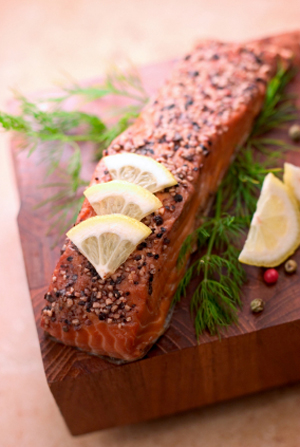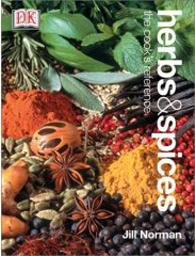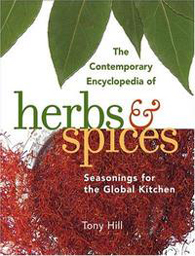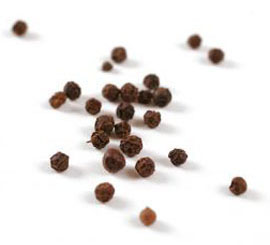 |


Black, white, pink, green: it’s only the beginning of your peppercorn education. Photo by Kelly Cline | IST. |
| WHAT IT IS: Varietal peppercorns—20 different pepper types and counting. |
|
WHY IT’S DIFFERENT: Each origin of the world produces pepper with different aromas and flavors—just like coffee beans and chocolate.
|
| WHY WE LOVE IT: Another way to vary food accents—and it has no calories! |
| WHERE TO BUY IT: Pepper-Passion.com, Kalustyans.com. |
|
|
 |

Varietal Peppercorns:
Spice Up Your Life
CAPSULE REPORT: You may or may not have mastered artisan salts, but it’s time to dive into gourmet peppercorns, the next wave of culinary excitement.
Even if you’ve been assiduous about buying whole peppercorns, you may never have had great pepper: Supermarket peppercorns are a commodity, as lackluster as supermarket honey. If you enjoy a grind of fresh black pepper on your salads, eggs, veggies and meats, this is going to be an eye-opening NIBBLE. If you’re a gourmet cook—or know one—ditto. Why bring another bottle of wine as a gift when you can bring a sampler that shows that “fine pepper” is as varied and complex as “fine wine?”
Read the full review below to learn about more than 20 different types of pepper and when to use them. Chef Stefan sells elaborate gift samplers, Pepper-Passion sells 4-variety samplers (and gift boxes) and Kalustyan’s sells 4-ounce bags of most varieties. Get ready to spice up your life.
|
More About Spices
 |
 |
 |
| Herbs & Spices: The Cook’s Reference, by Jill Norman (Editor). Flavor profiles of herbs and spices, with history, cooking techniques, recipes, herb blends and food pairings. Clear and colorful photos. Click here for more information or to purchase. |
The Contemporary Encyclopedia of Herbs and Spices: Seasonings for the Global Kitchen, by Tony Hill. An enthusiastic reference of 350 spices and herbs, with 75 different recipes and 200 color photos. Click here for more information or to purchase. |
The Spice and Herb Bible, by Ian Hemphill and Kate Hemphill. At 608 pages, this hefty book is a most comprehensive guide, with page after page of colorful photographs. Click here for more information or to purchase. |
Varietal Peppercorns: Spice Up Your Life
|
INDEX
This is Page 1 of an 11-page article. Click on the black links to visit other pages.
|
|
Overview
Remember when salt was either iodized or kosher? Now, if you aren’t serving beautiful salts from the seven seas plus artisanal varieties smoked over chardonnay barrels, coconut shells and kaffir lime leaves, you’re as exciting as a host who pours tap water. It’s the same with pepper. As a college student, when we first started Mastering The Art of French Cooking with Julia Child et al, there were black peppercorns and white peppercorns. We were schooled never to use anything sold pre-ground: Piperine, the chemical compound that provides pepper’s pungent (hot and biting) qualities, and the volatile oils that deliver its aroma, begin to dissipate thirty minutes after grinding exposes them to air. Grinding by peppermill or mortar and pestle—or even hand-crushing, we learned—was the only way to go.
A few years later, at Kalustyan’s spice market in New York City, we learned the difference between Malabar and Tellicherry peppercorns, grown on the southwestern coast of India—on the same vine! Then, what we thought of as “gourmet” peppercorns appeared on the scene. Pink peppercorns* arrived from Reunion, a French island southwest of Mauritius in the in the South Indian Ocean (and a stop for yachts en route to South Africa). Green peppercorns—actually unripe black peppercorns—appeared from India. Milder and fruitier than black corns, each added a very different pepper flavor plus bright color to dishes.
*Not from Piper nigrum, the pepper vine, but the berry of the Baies Rose Plant.
It’s taken another 20 years for pepper to make the next leap, but jump it has. Now you can choose your peppercorns the way you choose your coffee beans, wine or chocolate: based on varietal and terroir-related flavor characteristics. Just as artisan farmers specialize in producing microgreens and baby vegetables for top restaurants and gourmet homes, some pepper farmers are now focusing on growing the best peppercorns for chefs and connoisseurs.
|
Top restaurant chefs are always on the hunt for the next exciting ingredient, and pepper offers them versatility. Acclaimed chef Philippe Trosch, who recently left the Ventana Room in Tucson to start his own restaurant, had introduced a highly popular pepper-pairing program that offered guests a nightly selection of 12 to 15 peppercorn varieties. Based on what they ordered, guests were given five pepper selections in small pewter bowls, plus samples to take home to continue the tasting. For foie gras, which has a fat content that can stand up to a more robust pepper, Trosch chose spicier black Malabar pepper. For fish, which has more delicate flavors and less fat, he selected a milder pepper, such as Lampong. Roasted rabbit tenderloin with pancetta-and-braised-turnip mustard sauce has strong flavors that can stand up to Szechuan black pepper.
|
 Choose your terroir: Pick your black peppercorns
Choose your terroir: Pick your black peppercorns
based on your preferred level of heat and specific
flavor nuances.
|
Pepper goes straight through to the dessert table. Just as salt perks up any dish, pepper adds a dab of spice to pies, cookies, poached pears, baked apples, even ice cream and sorbet. In his book, Aquavit And the New Scandinavian Cuisine, Chef Marcus Samuelsson of New York City’s Aquavit restaurant serves up a Black Pepper Cheesecake; on Nantucket, a beautiful Pink Peppercorn Cheesecake by Chef Chris Freeman graces the menu at Oran Mor Bistro. Paris’s famed patissier Pierre Hermé is into black Sarawak pepper with fruit: You can make his Sweet Tomato “Tartare,” Black Sarawak Pepper & Coriander, Raspberry & Red Bell Pepper Sorbet and his Pineapple Carpaccio WIth Crystallized Coriander and Green Lime Sorbet (same link). At the risk of including ourselves in the same paragraph with Marcus Samuelsson and Pierre Hermé, we’ve added our own recipe for Strawberry Peppercorn Sorbet.
- You now can purchase five or more “single origin” black or white peppercorns and notice completely different aroma and flavor profiles. Just as you choose different chardonnay growing regions if you prefer more fruit and less acid, and tropical fruit rather than apple notes, you can go beyond India to Ecuador, Indonesia, Vietnam and other points around the equatorial belt to find the peppercorn that gives you the aroma, heat and flavor components you prefer.
- What was formerly a “seasoning” is now a key flavor ingredient: as a focus garnish on foie gras, in a pepper crust on a tenderloin or as the hot counterpoint in a frozen dessert. With so many varieties of pepper to pair with so many different foods, there’s no stopping imaginative chefs.
To borrow from the oyster, the world is your peppercorn. Our Top Pick Of The Week is not any one gourmet pepper, but all of them. We’ve provided shopping resources, from 4-ounce bags through beautiful gift samplers (that make a nice gift for yourself).
Before you plunge into the rest of this newsletter, we’ll give you the heads up that it’s long. Think of it as a seminar on peppercorns. If you don’t have time to read it now, bookmark it and come back later. As with all articles on TheNibble.com, we’ll be updating it as new peppercorns and other information become available.
Continue To Page 2: What Is Pepper?
Go To The Article Index Above
FOR ADDITIONAL INFORMATION, special offers, contests, opinion surveys, THE NIBBLE back issues archive, product gift-finder and more, visit the home page of TheNibble.com.
Do you have friends who would enjoy THE NIBBLE?
Click here
to send them an invitation to sign up for their own copy.
|
ABOUT THE NIBBLE. THE NIBBLE™, Great Food Finds™, is an online magazine about specialty foods and the gourmet life. It is the only consumer publication and website that focuses on reviewing the best specialty foods and beverages, in every category. The magazine also covers tabletop items, gourmet housewares, and other areas of interest to people who love fine food.
© Copyright 2004-<%response.write(Year(Date))%> Lifestyle Direct, Inc. All rights reserved. All information contained herein is subject to change at any time without notice. All details must be directly confirmed with manufacturers, service establishments and other third parties. This material may not be reproduced, distributed, transmitted, cached, or otherwise used, except with the prior written permission of Lifestyle Direct, Inc.
|
 |
|
 |









